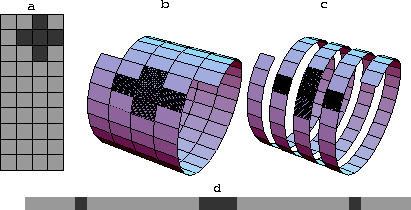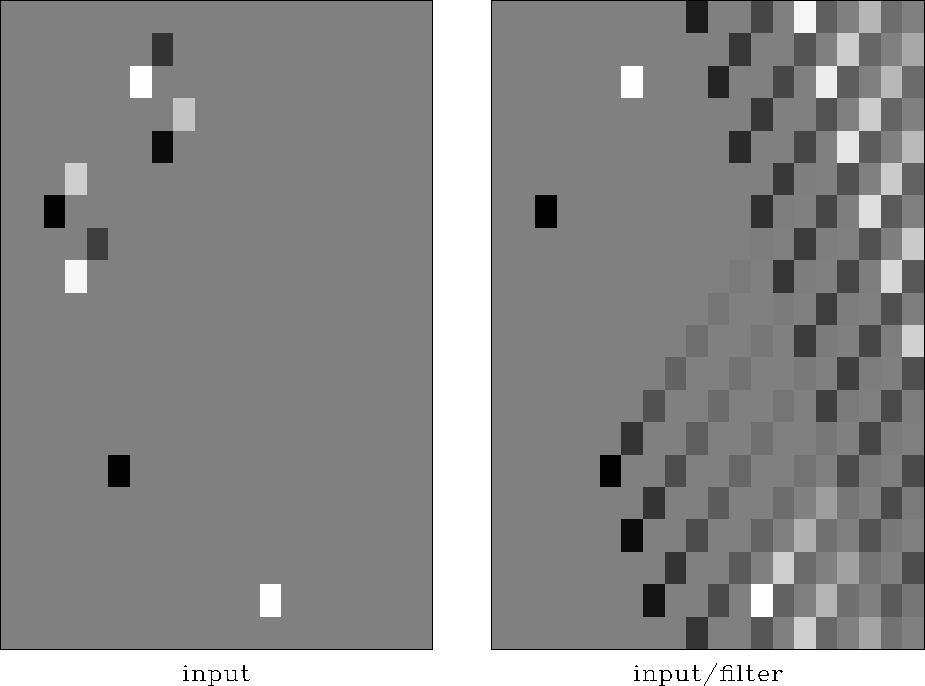




Next: Wilson-Burg spectral factorization
Up: Iterative data regularization
Previous: Regularization after binning: missing
Claerbout (1997, 1998a,c) proposed a
helix transform for mapping multidimensional convolution
operators to their one-dimensional equivalents. This transform proves
the feasibility of multidimensional deconvolution, an issue that has
been in question for more than 15 years. By mapping discrete
convolution operators to one-dimensional space, the inverse filtering
problem can be conveniently recast in terms of recursive filtering, a
well-known part of the digital filtering theory.
helix1
Figure 10 The helix transform of
two-dimensional filters to one dimension. The two-dimensional filter
in the left plot is equivalent to the one-dimensional filter in the
right plot, assuming that a shifted periodic condition is imposed on
one of the axes.





The helix filtering idea is schematically illustrated in
Figure ![[*]](http://sepwww.stanford.edu/latex2html/cross_ref_motif.gif) . The left plot (labeled ``a'' in the
figure) shows a two-dimensional digital filter overlayed on the
computational grid. A two-dimensional convolution computes its output
by sliding the filter over the plane. If we impose helical boundary
conditions on one of the axes, the filter will slide to the beginning
of the next trace after reaching the end of the previous one
(plot ``b''). As evident from plots ``c''
and ``d'', this is completely equivalent to one-dimensional
convolution with a long 1-D filter with internal gaps. For
efficiency, the gaps are simply ignored in a helical convolution
program. The computational gain is not, however, in the convolution
itself, but in the ability to perform recursive inverse filtering
(deconvolution) in multiple dimensions. A multi-dimensional filter is
mapped to its 1-D analog by imposing helical boundary conditions on
the appropriate axes. After that, inverse filtering is applied
recursively in a one-dimensional manner. Neglecting parallelization
and indexing issues, the cost of inverse filtering is equivalent to
the cost of convolution. It is proportional to the data size and to
the number of non-zero filter coefficients.
. The left plot (labeled ``a'' in the
figure) shows a two-dimensional digital filter overlayed on the
computational grid. A two-dimensional convolution computes its output
by sliding the filter over the plane. If we impose helical boundary
conditions on one of the axes, the filter will slide to the beginning
of the next trace after reaching the end of the previous one
(plot ``b''). As evident from plots ``c''
and ``d'', this is completely equivalent to one-dimensional
convolution with a long 1-D filter with internal gaps. For
efficiency, the gaps are simply ignored in a helical convolution
program. The computational gain is not, however, in the convolution
itself, but in the ability to perform recursive inverse filtering
(deconvolution) in multiple dimensions. A multi-dimensional filter is
mapped to its 1-D analog by imposing helical boundary conditions on
the appropriate axes. After that, inverse filtering is applied
recursively in a one-dimensional manner. Neglecting parallelization
and indexing issues, the cost of inverse filtering is equivalent to
the cost of convolution. It is proportional to the data size and to
the number of non-zero filter coefficients.
waves
Figure 11 Illustration of 2-D
deconvolution with helix transform. Left is the input: two spikes
and two filters. Right is the output of deconvolution.





An example of two-dimensional recursive filtering is shown in
Figure ![[*]](http://sepwww.stanford.edu/latex2html/cross_ref_motif.gif) . The left plot contains two spikes and two
filter impulse responses with different polarity. After deconvolution
with the given filter, the filter responses turn into spikes, and the
initial spikes turn into long-tailed inverse impulse responses (right
plot in Figure
. The left plot contains two spikes and two
filter impulse responses with different polarity. After deconvolution
with the given filter, the filter responses turn into spikes, and the
initial spikes turn into long-tailed inverse impulse responses (right
plot in Figure ![[*]](http://sepwww.stanford.edu/latex2html/cross_ref_motif.gif) ). Helical wrap-around, visible on the
horizontal boundaries, indicates the direction of the helix.
Claerbout (1999) presents more examples and discusses all the issues of
multidimensional helical deconvolution in detail.
). Helical wrap-around, visible on the
horizontal boundaries, indicates the direction of the helix.
Claerbout (1999) presents more examples and discusses all the issues of
multidimensional helical deconvolution in detail.
As is known from the one-dimensional theory Claerbout (1976),
a stable recursive filtering requires a minimum-phase filter, which
can be constructed with a spectral factorization algorithm. The
Wilson-Burg spectral factorization method, described in the next
section, is particularly convenient for helical filtering.





Next: Wilson-Burg spectral factorization
Up: Iterative data regularization
Previous: Regularization after binning: missing
Stanford Exploration Project
12/28/2000

![[*]](http://sepwww.stanford.edu/latex2html/cross_ref_motif.gif)
